UTS Nursing: Nebulizers vs. Spacers for Pediatric Asthma Treatment
VerifiedAdded on 2022/09/02
|8
|1923
|27
Report
AI Summary
This report examines the effectiveness of nebulizers versus spacers in delivering salbutamol to children with asthma, a critical clinical decision in pediatric care. The report begins with an introduction to asthma, its pathophysiology, and the role of inflammation and airway constriction. The core of the report compares various research studies, including randomized controlled trials, that have evaluated the efficacy and cost-effectiveness of both devices. Studies by Leo and Song (2017), Breuer et al. (2015), Krem et al. (1993), Leversha et al. (2000), and Robertson et al. (2003) are reviewed and compared, with the report highlighting the findings regarding clinical scores, respiratory rates, oxygen saturation, and heart rates. While some studies suggest nebulizers are more effective, others indicate spacers can be equally effective and more cost-effective. The report concludes by summarizing the findings and emphasizing the need for further research to determine the optimal method for administering salbutamol in children, considering both clinical outcomes and economic factors.

Running Head: N VS S 0
Nebulizers VS Spacers
JANUARY 7, 2020
Nebulizers VS Spacers
JANUARY 7, 2020
Paraphrase This Document
Need a fresh take? Get an instant paraphrase of this document with our AI Paraphraser

N VS S 1
Table of Contents
Introduction...........................................................................................................................................2
Nebulizers VS spacers.......................................................................................................................3
Conclusion.............................................................................................................................................5
References.............................................................................................................................................6
Table of Contents
Introduction...........................................................................................................................................2
Nebulizers VS spacers.......................................................................................................................3
Conclusion.............................................................................................................................................5
References.............................................................................................................................................6
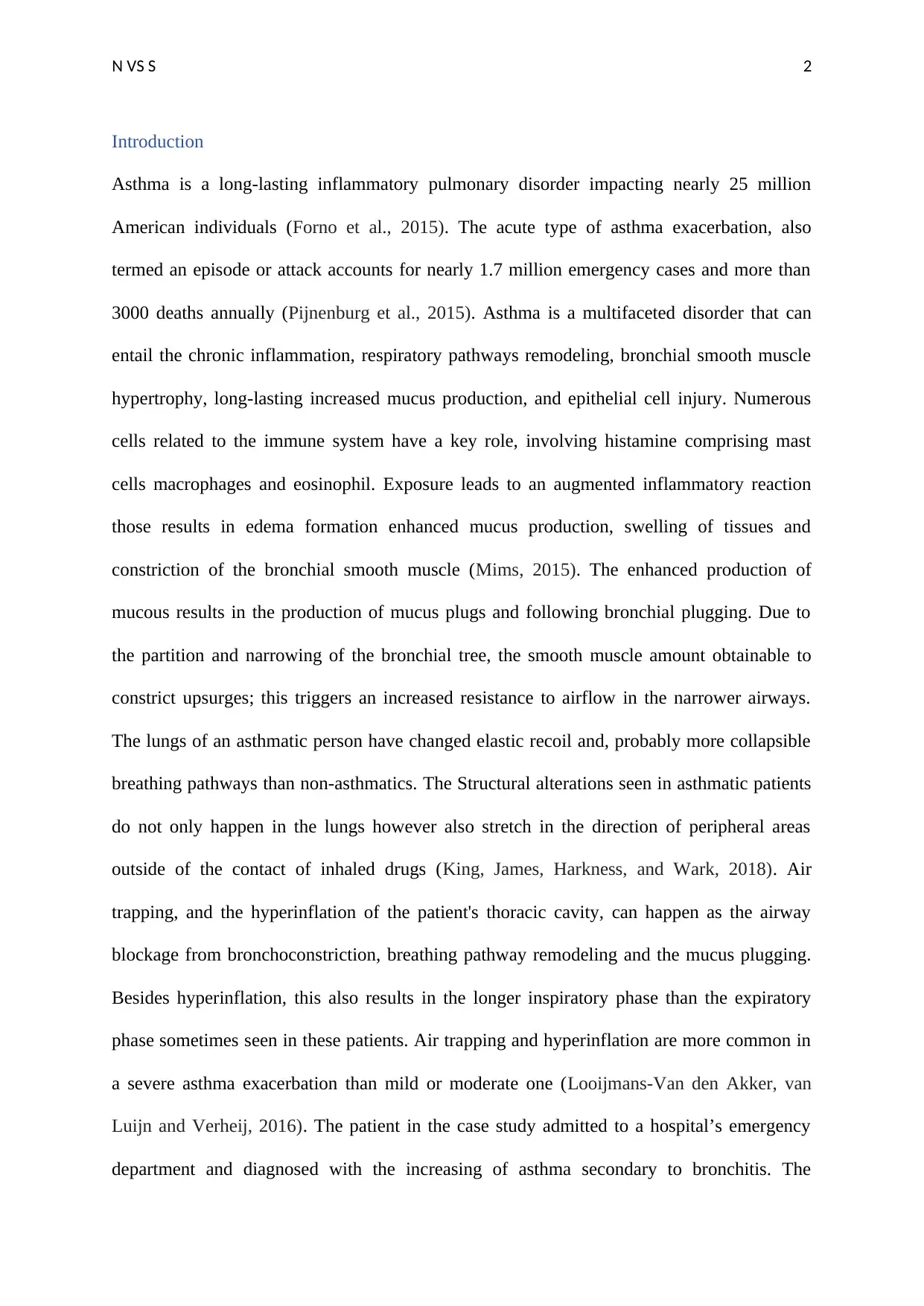
N VS S 2
Introduction
Asthma is a long-lasting inflammatory pulmonary disorder impacting nearly 25 million
American individuals (Forno et al., 2015). The acute type of asthma exacerbation, also
termed an episode or attack accounts for nearly 1.7 million emergency cases and more than
3000 deaths annually (Pijnenburg et al., 2015). Asthma is a multifaceted disorder that can
entail the chronic inflammation, respiratory pathways remodeling, bronchial smooth muscle
hypertrophy, long-lasting increased mucus production, and epithelial cell injury. Numerous
cells related to the immune system have a key role, involving histamine comprising mast
cells macrophages and eosinophil. Exposure leads to an augmented inflammatory reaction
those results in edema formation enhanced mucus production, swelling of tissues and
constriction of the bronchial smooth muscle (Mims, 2015). The enhanced production of
mucous results in the production of mucus plugs and following bronchial plugging. Due to
the partition and narrowing of the bronchial tree, the smooth muscle amount obtainable to
constrict upsurges; this triggers an increased resistance to airflow in the narrower airways.
The lungs of an asthmatic person have changed elastic recoil and, probably more collapsible
breathing pathways than non-asthmatics. The Structural alterations seen in asthmatic patients
do not only happen in the lungs however also stretch in the direction of peripheral areas
outside of the contact of inhaled drugs (King, James, Harkness, and Wark, 2018). Air
trapping, and the hyperinflation of the patient's thoracic cavity, can happen as the airway
blockage from bronchoconstriction, breathing pathway remodeling and the mucus plugging.
Besides hyperinflation, this also results in the longer inspiratory phase than the expiratory
phase sometimes seen in these patients. Air trapping and hyperinflation are more common in
a severe asthma exacerbation than mild or moderate one (Looijmans-Van den Akker, van
Luijn and Verheij, 2016). The patient in the case study admitted to a hospital’s emergency
department and diagnosed with the increasing of asthma secondary to bronchitis. The
Introduction
Asthma is a long-lasting inflammatory pulmonary disorder impacting nearly 25 million
American individuals (Forno et al., 2015). The acute type of asthma exacerbation, also
termed an episode or attack accounts for nearly 1.7 million emergency cases and more than
3000 deaths annually (Pijnenburg et al., 2015). Asthma is a multifaceted disorder that can
entail the chronic inflammation, respiratory pathways remodeling, bronchial smooth muscle
hypertrophy, long-lasting increased mucus production, and epithelial cell injury. Numerous
cells related to the immune system have a key role, involving histamine comprising mast
cells macrophages and eosinophil. Exposure leads to an augmented inflammatory reaction
those results in edema formation enhanced mucus production, swelling of tissues and
constriction of the bronchial smooth muscle (Mims, 2015). The enhanced production of
mucous results in the production of mucus plugs and following bronchial plugging. Due to
the partition and narrowing of the bronchial tree, the smooth muscle amount obtainable to
constrict upsurges; this triggers an increased resistance to airflow in the narrower airways.
The lungs of an asthmatic person have changed elastic recoil and, probably more collapsible
breathing pathways than non-asthmatics. The Structural alterations seen in asthmatic patients
do not only happen in the lungs however also stretch in the direction of peripheral areas
outside of the contact of inhaled drugs (King, James, Harkness, and Wark, 2018). Air
trapping, and the hyperinflation of the patient's thoracic cavity, can happen as the airway
blockage from bronchoconstriction, breathing pathway remodeling and the mucus plugging.
Besides hyperinflation, this also results in the longer inspiratory phase than the expiratory
phase sometimes seen in these patients. Air trapping and hyperinflation are more common in
a severe asthma exacerbation than mild or moderate one (Looijmans-Van den Akker, van
Luijn and Verheij, 2016). The patient in the case study admitted to a hospital’s emergency
department and diagnosed with the increasing of asthma secondary to bronchitis. The
⊘ This is a preview!⊘
Do you want full access?
Subscribe today to unlock all pages.

Trusted by 1+ million students worldwide
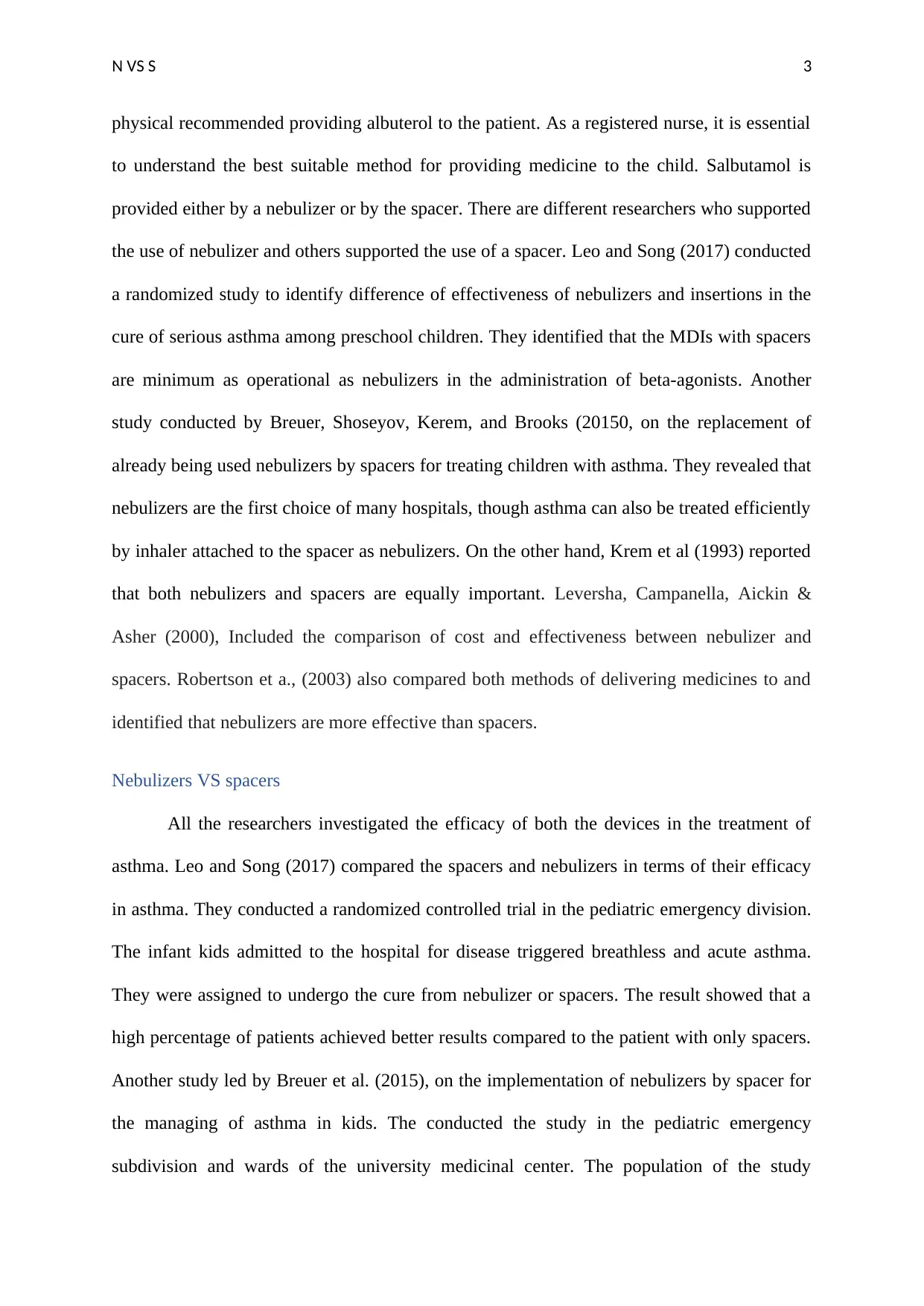
N VS S 3
physical recommended providing albuterol to the patient. As a registered nurse, it is essential
to understand the best suitable method for providing medicine to the child. Salbutamol is
provided either by a nebulizer or by the spacer. There are different researchers who supported
the use of nebulizer and others supported the use of a spacer. Leo and Song (2017) conducted
a randomized study to identify difference of effectiveness of nebulizers and insertions in the
cure of serious asthma among preschool children. They identified that the MDIs with spacers
are minimum as operational as nebulizers in the administration of beta-agonists. Another
study conducted by Breuer, Shoseyov, Kerem, and Brooks (20150, on the replacement of
already being used nebulizers by spacers for treating children with asthma. They revealed that
nebulizers are the first choice of many hospitals, though asthma can also be treated efficiently
by inhaler attached to the spacer as nebulizers. On the other hand, Krem et al (1993) reported
that both nebulizers and spacers are equally important. Leversha, Campanella, Aickin &
Asher (2000), Included the comparison of cost and effectiveness between nebulizer and
spacers. Robertson et a., (2003) also compared both methods of delivering medicines to and
identified that nebulizers are more effective than spacers.
Nebulizers VS spacers
All the researchers investigated the efficacy of both the devices in the treatment of
asthma. Leo and Song (2017) compared the spacers and nebulizers in terms of their efficacy
in asthma. They conducted a randomized controlled trial in the pediatric emergency division.
The infant kids admitted to the hospital for disease triggered breathless and acute asthma.
They were assigned to undergo the cure from nebulizer or spacers. The result showed that a
high percentage of patients achieved better results compared to the patient with only spacers.
Another study led by Breuer et al. (2015), on the implementation of nebulizers by spacer for
the managing of asthma in kids. The conducted the study in the pediatric emergency
subdivision and wards of the university medicinal center. The population of the study
physical recommended providing albuterol to the patient. As a registered nurse, it is essential
to understand the best suitable method for providing medicine to the child. Salbutamol is
provided either by a nebulizer or by the spacer. There are different researchers who supported
the use of nebulizer and others supported the use of a spacer. Leo and Song (2017) conducted
a randomized study to identify difference of effectiveness of nebulizers and insertions in the
cure of serious asthma among preschool children. They identified that the MDIs with spacers
are minimum as operational as nebulizers in the administration of beta-agonists. Another
study conducted by Breuer, Shoseyov, Kerem, and Brooks (20150, on the replacement of
already being used nebulizers by spacers for treating children with asthma. They revealed that
nebulizers are the first choice of many hospitals, though asthma can also be treated efficiently
by inhaler attached to the spacer as nebulizers. On the other hand, Krem et al (1993) reported
that both nebulizers and spacers are equally important. Leversha, Campanella, Aickin &
Asher (2000), Included the comparison of cost and effectiveness between nebulizer and
spacers. Robertson et a., (2003) also compared both methods of delivering medicines to and
identified that nebulizers are more effective than spacers.
Nebulizers VS spacers
All the researchers investigated the efficacy of both the devices in the treatment of
asthma. Leo and Song (2017) compared the spacers and nebulizers in terms of their efficacy
in asthma. They conducted a randomized controlled trial in the pediatric emergency division.
The infant kids admitted to the hospital for disease triggered breathless and acute asthma.
They were assigned to undergo the cure from nebulizer or spacers. The result showed that a
high percentage of patients achieved better results compared to the patient with only spacers.
Another study led by Breuer et al. (2015), on the implementation of nebulizers by spacer for
the managing of asthma in kids. The conducted the study in the pediatric emergency
subdivision and wards of the university medicinal center. The population of the study
Paraphrase This Document
Need a fresh take? Get an instant paraphrase of this document with our AI Paraphraser
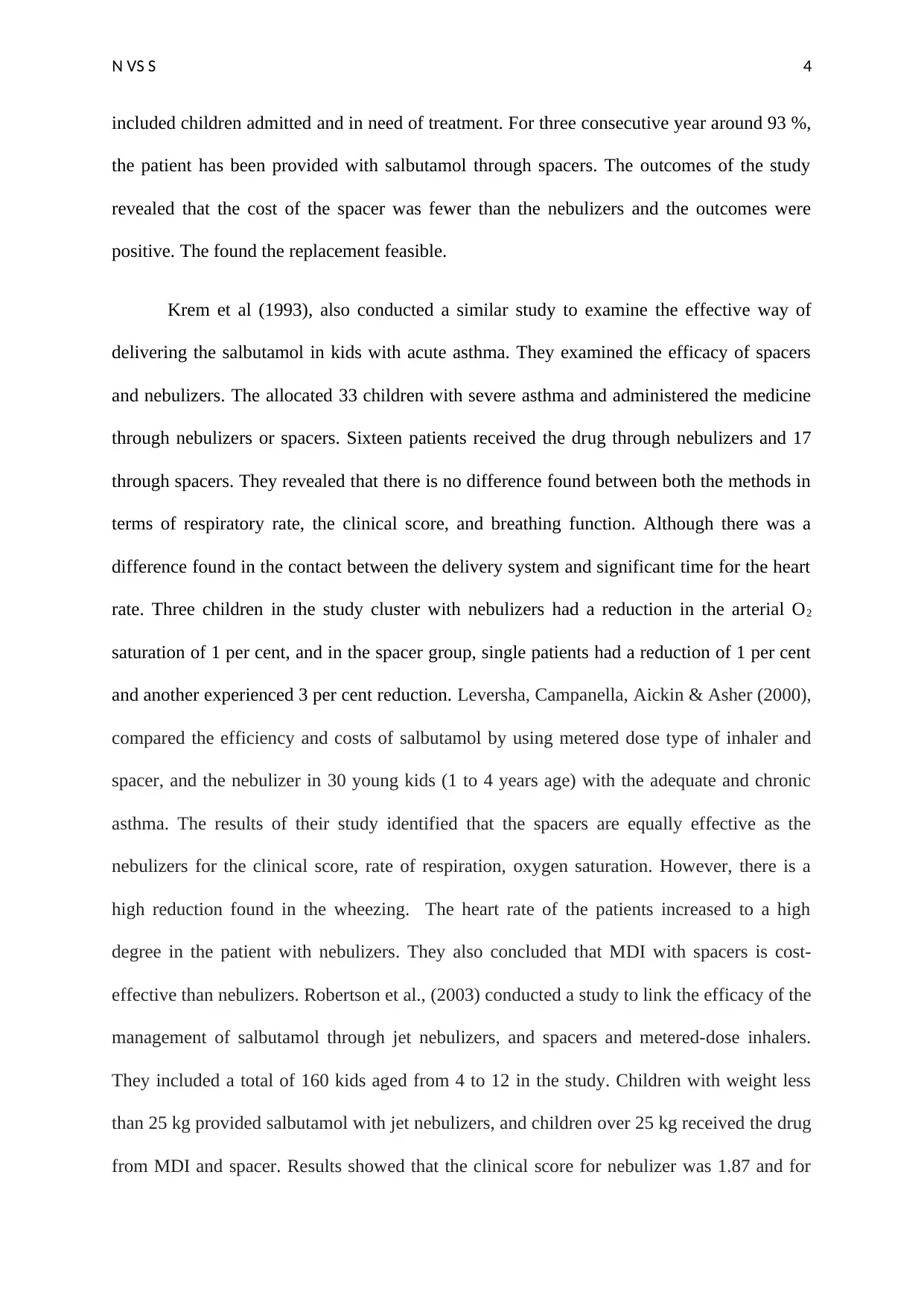
N VS S 4
included children admitted and in need of treatment. For three consecutive year around 93 %,
the patient has been provided with salbutamol through spacers. The outcomes of the study
revealed that the cost of the spacer was fewer than the nebulizers and the outcomes were
positive. The found the replacement feasible.
Krem et al (1993), also conducted a similar study to examine the effective way of
delivering the salbutamol in kids with acute asthma. They examined the efficacy of spacers
and nebulizers. The allocated 33 children with severe asthma and administered the medicine
through nebulizers or spacers. Sixteen patients received the drug through nebulizers and 17
through spacers. They revealed that there is no difference found between both the methods in
terms of respiratory rate, the clinical score, and breathing function. Although there was a
difference found in the contact between the delivery system and significant time for the heart
rate. Three children in the study cluster with nebulizers had a reduction in the arterial O2
saturation of 1 per cent, and in the spacer group, single patients had a reduction of 1 per cent
and another experienced 3 per cent reduction. Leversha, Campanella, Aickin & Asher (2000),
compared the efficiency and costs of salbutamol by using metered dose type of inhaler and
spacer, and the nebulizer in 30 young kids (1 to 4 years age) with the adequate and chronic
asthma. The results of their study identified that the spacers are equally effective as the
nebulizers for the clinical score, rate of respiration, oxygen saturation. However, there is a
high reduction found in the wheezing. The heart rate of the patients increased to a high
degree in the patient with nebulizers. They also concluded that MDI with spacers is cost-
effective than nebulizers. Robertson et al., (2003) conducted a study to link the efficacy of the
management of salbutamol through jet nebulizers, and spacers and metered-dose inhalers.
They included a total of 160 kids aged from 4 to 12 in the study. Children with weight less
than 25 kg provided salbutamol with jet nebulizers, and children over 25 kg received the drug
from MDI and spacer. Results showed that the clinical score for nebulizer was 1.87 and for
included children admitted and in need of treatment. For three consecutive year around 93 %,
the patient has been provided with salbutamol through spacers. The outcomes of the study
revealed that the cost of the spacer was fewer than the nebulizers and the outcomes were
positive. The found the replacement feasible.
Krem et al (1993), also conducted a similar study to examine the effective way of
delivering the salbutamol in kids with acute asthma. They examined the efficacy of spacers
and nebulizers. The allocated 33 children with severe asthma and administered the medicine
through nebulizers or spacers. Sixteen patients received the drug through nebulizers and 17
through spacers. They revealed that there is no difference found between both the methods in
terms of respiratory rate, the clinical score, and breathing function. Although there was a
difference found in the contact between the delivery system and significant time for the heart
rate. Three children in the study cluster with nebulizers had a reduction in the arterial O2
saturation of 1 per cent, and in the spacer group, single patients had a reduction of 1 per cent
and another experienced 3 per cent reduction. Leversha, Campanella, Aickin & Asher (2000),
compared the efficiency and costs of salbutamol by using metered dose type of inhaler and
spacer, and the nebulizer in 30 young kids (1 to 4 years age) with the adequate and chronic
asthma. The results of their study identified that the spacers are equally effective as the
nebulizers for the clinical score, rate of respiration, oxygen saturation. However, there is a
high reduction found in the wheezing. The heart rate of the patients increased to a high
degree in the patient with nebulizers. They also concluded that MDI with spacers is cost-
effective than nebulizers. Robertson et al., (2003) conducted a study to link the efficacy of the
management of salbutamol through jet nebulizers, and spacers and metered-dose inhalers.
They included a total of 160 kids aged from 4 to 12 in the study. Children with weight less
than 25 kg provided salbutamol with jet nebulizers, and children over 25 kg received the drug
from MDI and spacer. Results showed that the clinical score for nebulizer was 1.87 and for
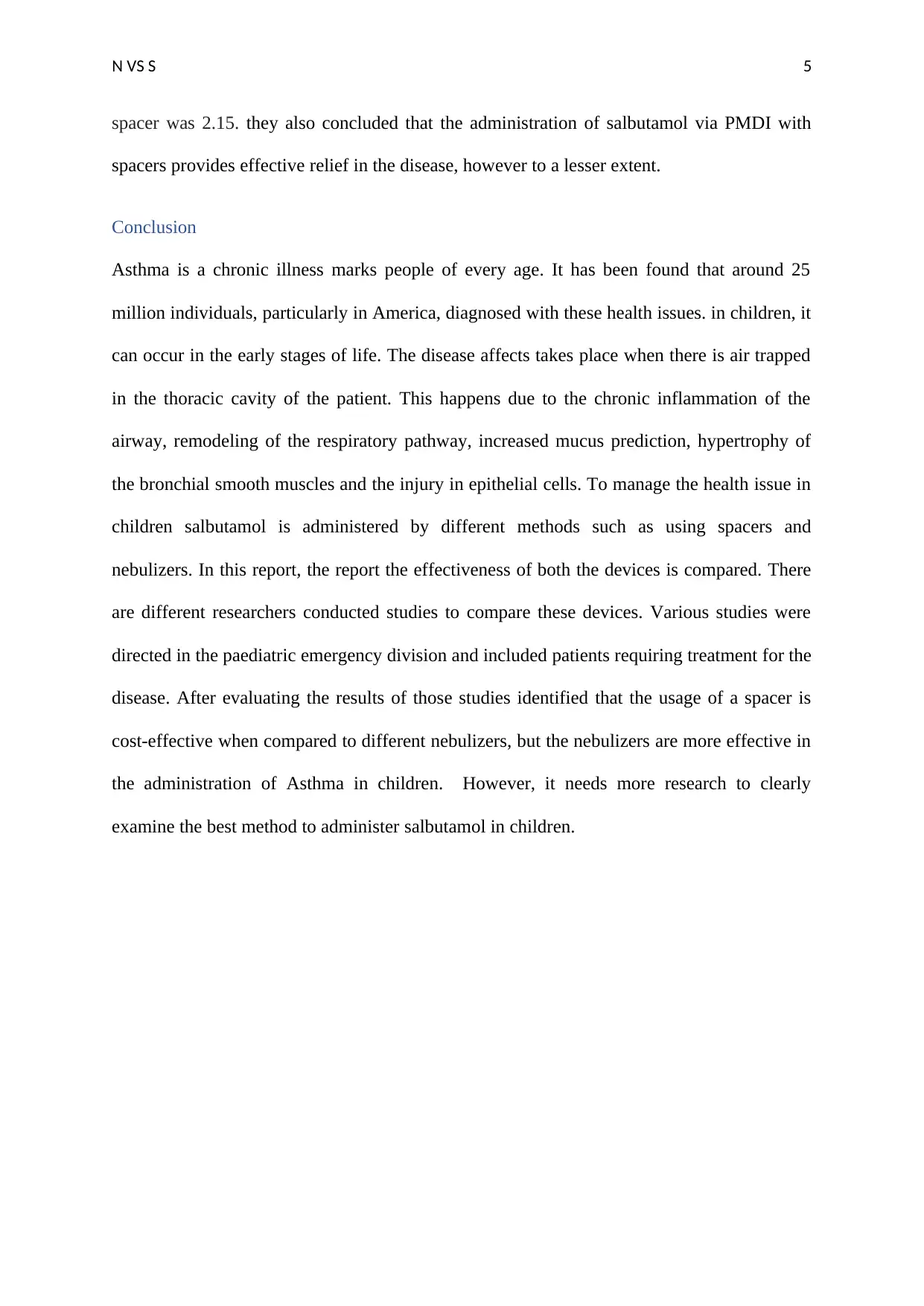
N VS S 5
spacer was 2.15. they also concluded that the administration of salbutamol via PMDI with
spacers provides effective relief in the disease, however to a lesser extent.
Conclusion
Asthma is a chronic illness marks people of every age. It has been found that around 25
million individuals, particularly in America, diagnosed with these health issues. in children, it
can occur in the early stages of life. The disease affects takes place when there is air trapped
in the thoracic cavity of the patient. This happens due to the chronic inflammation of the
airway, remodeling of the respiratory pathway, increased mucus prediction, hypertrophy of
the bronchial smooth muscles and the injury in epithelial cells. To manage the health issue in
children salbutamol is administered by different methods such as using spacers and
nebulizers. In this report, the report the effectiveness of both the devices is compared. There
are different researchers conducted studies to compare these devices. Various studies were
directed in the paediatric emergency division and included patients requiring treatment for the
disease. After evaluating the results of those studies identified that the usage of a spacer is
cost-effective when compared to different nebulizers, but the nebulizers are more effective in
the administration of Asthma in children. However, it needs more research to clearly
examine the best method to administer salbutamol in children.
spacer was 2.15. they also concluded that the administration of salbutamol via PMDI with
spacers provides effective relief in the disease, however to a lesser extent.
Conclusion
Asthma is a chronic illness marks people of every age. It has been found that around 25
million individuals, particularly in America, diagnosed with these health issues. in children, it
can occur in the early stages of life. The disease affects takes place when there is air trapped
in the thoracic cavity of the patient. This happens due to the chronic inflammation of the
airway, remodeling of the respiratory pathway, increased mucus prediction, hypertrophy of
the bronchial smooth muscles and the injury in epithelial cells. To manage the health issue in
children salbutamol is administered by different methods such as using spacers and
nebulizers. In this report, the report the effectiveness of both the devices is compared. There
are different researchers conducted studies to compare these devices. Various studies were
directed in the paediatric emergency division and included patients requiring treatment for the
disease. After evaluating the results of those studies identified that the usage of a spacer is
cost-effective when compared to different nebulizers, but the nebulizers are more effective in
the administration of Asthma in children. However, it needs more research to clearly
examine the best method to administer salbutamol in children.
⊘ This is a preview!⊘
Do you want full access?
Subscribe today to unlock all pages.

Trusted by 1+ million students worldwide

N VS S 6
References
Breuer, O., Shoseyov, D., Kerem, E. and Brooks, R., 2015. Implementation of a Policy
Change: Replacement of Nebulizers by Spacers for the Treatment of Asthma in
Children. The Israel Medical Association journal: IMAJ, 17(7), pp.421-424.
Forno, E., Gogna, M., Cepeda, A., Yañez, A., Solé, D., Cooper, P., Avila, L., Soto-Quiros,
M., Castro-Rodriguez, J.A. and Celedón, J.C., 2015. Asthma in latin
America. Thorax, 70(9), pp.898-905.
Kerem, E., Levison, H., Schuh, S., O'Brodovich, H., Reisman, J., Bentur, L. and Canny, G.J.,
1993. Efficacy of albuterol administered by nebulizer versus spacer device in children
with acute asthma. The Journal of pediatrics, 123(2), pp.313-317.
King, G.G., James, A., Harkness, L. and Wark, P.A., 2018. Pathophysiology of severe
asthma: we’ve only just started. Respirology, 23(3), pp.262-271.
Leo, H.L. and Song, B.J., 2017. Spacers Versus Nebulizers in Treatment of Acute Asthma-A
Prospective Randomized Study in Preschool Children. Pediatrics, 140(Supplement 3),
pp.S218-S218.
Leversha, A.M., Campanella, S.G., Aickin, R.P. and Asher, M.I., 2000. Costs and
effectiveness of spacer versus nebulizer in young children with moderate and severe
acute asthma. The Journal of pediatrics, 136(4), pp.497-502.
Looijmans-Van den Akker, I., van Luijn, K. and Verheij, T., 2016. Overdiagnosis of asthma
in children in primary care: a retrospective analysis. Br J Gen Pract, 66(644),
pp.e152-e157.
References
Breuer, O., Shoseyov, D., Kerem, E. and Brooks, R., 2015. Implementation of a Policy
Change: Replacement of Nebulizers by Spacers for the Treatment of Asthma in
Children. The Israel Medical Association journal: IMAJ, 17(7), pp.421-424.
Forno, E., Gogna, M., Cepeda, A., Yañez, A., Solé, D., Cooper, P., Avila, L., Soto-Quiros,
M., Castro-Rodriguez, J.A. and Celedón, J.C., 2015. Asthma in latin
America. Thorax, 70(9), pp.898-905.
Kerem, E., Levison, H., Schuh, S., O'Brodovich, H., Reisman, J., Bentur, L. and Canny, G.J.,
1993. Efficacy of albuterol administered by nebulizer versus spacer device in children
with acute asthma. The Journal of pediatrics, 123(2), pp.313-317.
King, G.G., James, A., Harkness, L. and Wark, P.A., 2018. Pathophysiology of severe
asthma: we’ve only just started. Respirology, 23(3), pp.262-271.
Leo, H.L. and Song, B.J., 2017. Spacers Versus Nebulizers in Treatment of Acute Asthma-A
Prospective Randomized Study in Preschool Children. Pediatrics, 140(Supplement 3),
pp.S218-S218.
Leversha, A.M., Campanella, S.G., Aickin, R.P. and Asher, M.I., 2000. Costs and
effectiveness of spacer versus nebulizer in young children with moderate and severe
acute asthma. The Journal of pediatrics, 136(4), pp.497-502.
Looijmans-Van den Akker, I., van Luijn, K. and Verheij, T., 2016. Overdiagnosis of asthma
in children in primary care: a retrospective analysis. Br J Gen Pract, 66(644),
pp.e152-e157.
Paraphrase This Document
Need a fresh take? Get an instant paraphrase of this document with our AI Paraphraser
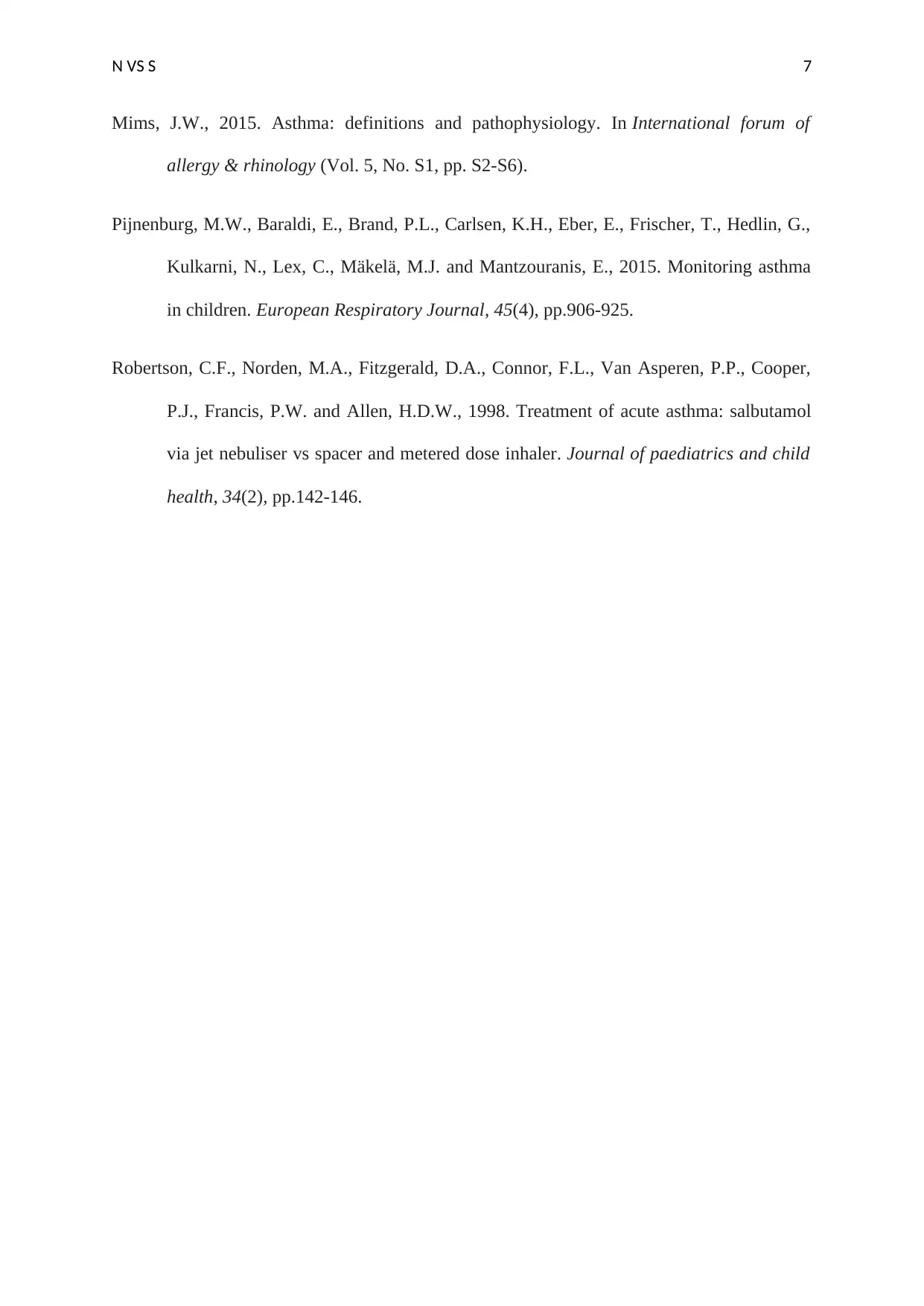
N VS S 7
Mims, J.W., 2015. Asthma: definitions and pathophysiology. In International forum of
allergy & rhinology (Vol. 5, No. S1, pp. S2-S6).
Pijnenburg, M.W., Baraldi, E., Brand, P.L., Carlsen, K.H., Eber, E., Frischer, T., Hedlin, G.,
Kulkarni, N., Lex, C., Mäkelä, M.J. and Mantzouranis, E., 2015. Monitoring asthma
in children. European Respiratory Journal, 45(4), pp.906-925.
Robertson, C.F., Norden, M.A., Fitzgerald, D.A., Connor, F.L., Van Asperen, P.P., Cooper,
P.J., Francis, P.W. and Allen, H.D.W., 1998. Treatment of acute asthma: salbutamol
via jet nebuliser vs spacer and metered dose inhaler. Journal of paediatrics and child
health, 34(2), pp.142-146.
Mims, J.W., 2015. Asthma: definitions and pathophysiology. In International forum of
allergy & rhinology (Vol. 5, No. S1, pp. S2-S6).
Pijnenburg, M.W., Baraldi, E., Brand, P.L., Carlsen, K.H., Eber, E., Frischer, T., Hedlin, G.,
Kulkarni, N., Lex, C., Mäkelä, M.J. and Mantzouranis, E., 2015. Monitoring asthma
in children. European Respiratory Journal, 45(4), pp.906-925.
Robertson, C.F., Norden, M.A., Fitzgerald, D.A., Connor, F.L., Van Asperen, P.P., Cooper,
P.J., Francis, P.W. and Allen, H.D.W., 1998. Treatment of acute asthma: salbutamol
via jet nebuliser vs spacer and metered dose inhaler. Journal of paediatrics and child
health, 34(2), pp.142-146.
1 out of 8
Related Documents
Your All-in-One AI-Powered Toolkit for Academic Success.
+13062052269
info@desklib.com
Available 24*7 on WhatsApp / Email
![[object Object]](/_next/static/media/star-bottom.7253800d.svg)
Unlock your academic potential
Copyright © 2020–2025 A2Z Services. All Rights Reserved. Developed and managed by ZUCOL.





